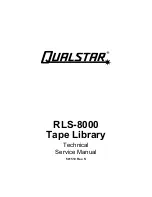
Seagate Exos X18 SAS Product Manual, Rev. D
14
www.seagate.com
Performance characteristics
4.3
Prefetch/multi-segmented cache control
The drive provides a prefetch (read look-ahead) and multi-segmented cache control algorithms that in many cases can enhance system
performance. Cache refers to the drive buffer storage space when it is used in cache operations. To select this feature, the host sends the Mode
Select command with the proper values in the applicable bytes in page 08h. Prefetch and cache operations are independent features from the
standpoint that each is enabled and disabled independently using the Mode Select command; however, in actual operation, the prefetch feature
overlaps cache operation somewhat as described in sections
Table 4.4.1
and
Table 4.4.2
.
All default cache and prefetch mode parameter values (Mode Page 08h) for standard OEM versions of this drive family are given in
Table 10
.
4.4
Cache operation
.
The buffer is divided into logical segments from which data is read and to which data is written.
The drive keeps track of the logical block addresses of the data stored in each segment of the buffer. If the cache is enabled (see RCD bit in the
SAS
Interface Manual
), data requested by the host with a read command is retrieved from the buffer, if possible, before any disk access is initiated. If
cache operation is not enabled, the buffer is still used, but only as circular buffer segments during disk medium read operations (disregarding
Prefetch operation for the moment). That is, the drive does not check in the buffer segments for the requested read data, but goes directly to the
medium to retrieve it. The retrieved data merely passes through some buffer segment on the way to the host. All data transfers to the host are in
accordance with buffer-full ratio rules. See the explanation provided with the information about Mode Page 02h (disconnect/reconnect control)
in the
SAS Interface Manual
.
The following is a simplified description of the prefetch/cache operation:
Case A
—read command is received and all of the requested logical blocks are already in the cache:
1.
Drive transfers the requested logical blocks to the initiator.
Case B
—A Read command requests data, and at least one requested logical block is not in any segment of the cache:
1.
The drive fetches the requested logical blocks from the disk and transfers them into a segment, and then from there to the host in accor-
dance with the Mode Select Disconnect/Reconnect parameters, page 02h.
2.
If the prefetch feature is enabled, refer to section
Table 4.4.2
for operation from this point.
Each cache segment is actually a self-contained circular buffer whose length is an integer number of logical blocks. The drive dynamically creates
and removes segments based on the workload. The wrap-around capability of the individual segments greatly enhances the cache’s overall
performance.
The size of each segment is not reported by Mode Sense command page 08h, bytes 14 and 15. The value 0XFFFF is always reported regardless of
the actual size of the segment. Sending a size specification using the Mode Select command (bytes 14 and 15) does not set up a new segment
size. If the STRICT bit in Mode page 00h (byte 2, bit 1) is set to one, the drive responds as it does for any attempt to change an unchangeable
parameter.
Note
Refer to the
SAS Interface Manual
for more detail concerning the cache bits.
















































